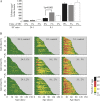Prolongevity effects of an oregano and cranberry extract are diet dependent in the Mexican fruit fly (Anastrepha ludens)
- PMID: 19906819
- PMCID: PMC2796885
- DOI: 10.1093/gerona/glp176
Prolongevity effects of an oregano and cranberry extract are diet dependent in the Mexican fruit fly (Anastrepha ludens)
Abstract
Botanicals have numerous health benefits. Here, we used the Mexican fruit fly to screen 14 compounds and botanicals for their prolongevity effects and found an oregano and cranberry mixture (OC) improved survival. We then evaluated prolongevity effects of OC within the context of diet composition. Individual flies were fed 0%, 1%, or 2% OC in one of the three diets containing sugar and yeast extract (SY) at a ratio of 3:1, 9:1, or 24:1. We found that prolongevity effects of OC depended upon dose, gender, and diet composition. The greatest increase in longevity was observed in females fed the SY24:1 diet with 2% OC compared to the non-supplemented diet. OC did not reduce egg laying and, hence, did not compromise fecundity under any dietary condition tested here. This study reveals the prolongevity effects of OC and supports the emerging view that benefits of botanicals on aging depend on diet composition and gender.
Figures





Similar articles
-
Prolongevity effects of a botanical with oregano and cranberry extracts in Mexican fruit flies: examining interactions of diet restriction and age.Age (Dordr). 2012 Apr;34(2):269-79. doi: 10.1007/s11357-011-9230-8. Epub 2011 Apr 1. Age (Dordr). 2012. PMID: 21455602 Free PMC article.
-
The interplay among dietary fat, sugar, protein and açai (Euterpe oleracea Mart.) pulp in modulating lifespan and reproduction in a Tephritid fruit fly.Exp Gerontol. 2012 Jul;47(7):536-9. doi: 10.1016/j.exger.2012.05.001. Epub 2012 May 11. Exp Gerontol. 2012. PMID: 22580089 Free PMC article.
-
The prolongevity effect of resveratrol depends on dietary composition and calorie intake in a tephritid fruit fly.Exp Gerontol. 2009 Jun-Jul;44(6-7):472-6. doi: 10.1016/j.exger.2009.02.011. Epub 2009 Mar 3. Exp Gerontol. 2009. PMID: 19264118 Free PMC article.
-
Cranberry interacts with dietary macronutrients to promote healthy aging in Drosophila.J Gerontol A Biol Sci Med Sci. 2014 Aug;69(8):945-54. doi: 10.1093/gerona/glt161. Epub 2013 Oct 22. J Gerontol A Biol Sci Med Sci. 2014. PMID: 24149429 Free PMC article.
-
Host marking pheromone (HMP) in the Mexican fruit fly Anastrepha ludens.Chimia (Aarau). 2010;64(1-2):37-42. doi: 10.2533/chimia.2010.37. Chimia (Aarau). 2010. PMID: 21137682 Review.
Cited by
-
Nutraceutical interventions for promoting healthy aging in invertebrate models.Oxid Med Cell Longev. 2012;2012:718491. doi: 10.1155/2012/718491. Epub 2012 Sep 6. Oxid Med Cell Longev. 2012. PMID: 22991584 Free PMC article. Review.
-
Adaptive cellular stress pathways as therapeutic targets of dietary phytochemicals: focus on the nervous system.Pharmacol Rev. 2014 Jul;66(3):815-68. doi: 10.1124/pr.113.007757. Pharmacol Rev. 2014. PMID: 24958636 Free PMC article. Review.
-
Prolongevity effects of a botanical with oregano and cranberry extracts in Mexican fruit flies: examining interactions of diet restriction and age.Age (Dordr). 2012 Apr;34(2):269-79. doi: 10.1007/s11357-011-9230-8. Epub 2011 Apr 1. Age (Dordr). 2012. PMID: 21455602 Free PMC article.
-
New Insights for Cellular and Molecular Mechanisms of Aging and Aging-Related Diseases: Herbal Medicine as Potential Therapeutic Approach.Oxid Med Cell Longev. 2019 Dec 12;2019:4598167. doi: 10.1155/2019/4598167. eCollection 2019. Oxid Med Cell Longev. 2019. PMID: 31915506 Free PMC article. Review.
-
Effects of long-term cranberry supplementation on endocrine pancreas in aging rats.J Gerontol A Biol Sci Med Sci. 2011 Nov;66(11):1139-51. doi: 10.1093/gerona/glr105. Epub 2011 Jul 18. J Gerontol A Biol Sci Med Sci. 2011. PMID: 21768504 Free PMC article.
References
-
- Liu RH. Potential synergy of phytochemicals in cancer prevention: mechanism of action. J Nutr. 2004;134:3479S–3485S. - PubMed
-
- Ferguson LR, Philpott M. Cancer prevention by dietary bioactive components that target the immune response. Curr Cancer Drug Targets. 2007;7:459–464. - PubMed
-
- Spencer JP. Flavonoids: modulators of brain function? Br J Nutr. 2008;99(E suppl 1):ES60–ES77. - PubMed
Publication types
MeSH terms
Substances
Grants and funding
LinkOut - more resources
Full Text Sources
Molecular Biology Databases

